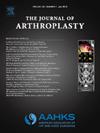Staying Ahead of the Curve: The Case for Recovery Curves in Total Knee Arthroplasty
IF 3.4
2区 医学
Q1 ORTHOPEDICS
引用次数: 0
Abstract
Background
Sensor technology embedded within the total knee arthroplasty (TKA) implant has the potential to record data that can track recovery and provide diagnostic information. In this study, we introduce the concept of physical function recovery curve analytics, which are created from daily spatial-temporal gait metrics and step counts from a large cohort of TKA patients.
Methods
In our study population, 258 patients underwent a primary TKA with a smart implanted tibial extension between October 4, 2021, and July 15, 2022, by 33 surgeons. The average age was 63 years, with 138 (54%) women. All kinematic data were collected on a Health Insurance Portability and Accountability Act–compliant cloud data management platform.
Results
Summaries of the gait parameters at 6 weeks are suggestive of differences between people over and under 65 years, with the older patients walking more slowly and having shorter stride lengths. The 6-week percentiles demonstrated a strong linear correlation to the 12-week percentiles for each gait parameter, with correlation coefficients ranging from 0.87 to 0.92.
Conclusions
A novel screening gait test at 6 weeks shows promising results for predicting patients who will likely have poor recovery based on at least one gait parameter recovery curve at 12 weeks with high sensitivity and specificity. A future study is needed to validate the screening tool with an independent set of patients.
保持领先:全膝关节置换术的恢复曲线案例。
背景:嵌入全膝关节置换术(TKA)假体的传感器技术有可能记录数据,从而跟踪恢复情况并提供诊断信息。在这项研究中,我们引入了身体功能恢复曲线分析的概念,该分析是根据一大批 TKA 患者的每日时空步态指标和步数创建的:在我们的研究人群中,有 258 名患者在 2021 年 10 月 4 日至 2022 年 7 月 15 日期间接受了由 33 名外科医生实施的带有智能植入胫骨延长器的初次 TKA。平均年龄为 63 岁,其中 138 人(54%)为女性。所有运动学数据都是在符合《健康保险可携性与责任法案》(HIPAA)的云数据管理平台上收集的:结果:6周时的步态参数摘要表明,65岁以上和65岁以下的人之间存在差异,老年患者行走速度更慢,步幅更短。每项步态参数的 6 周百分位数与 12 周百分位数都有很强的线性相关,相关系数在 0.87 到 0.92 之间:一项新颖的 6 周筛查步态测试显示,根据至少一项步态参数在 12 周时的恢复曲线,预测可能恢复不佳的患者具有较高的灵敏度和特异性。未来的研究需要在一组独立的患者中验证该筛查工具。
本文章由计算机程序翻译,如有差异,请以英文原文为准。
求助全文
约1分钟内获得全文
求助全文
来源期刊

Journal of Arthroplasty
医学-整形外科
CiteScore
7.00
自引率
20.00%
发文量
734
审稿时长
48 days
期刊介绍:
The Journal of Arthroplasty brings together the clinical and scientific foundations for joint replacement. This peer-reviewed journal publishes original research and manuscripts of the highest quality from all areas relating to joint replacement or the treatment of its complications, including those dealing with clinical series and experience, prosthetic design, biomechanics, biomaterials, metallurgy, biologic response to arthroplasty materials in vivo and in vitro.
 求助内容:
求助内容: 应助结果提醒方式:
应助结果提醒方式:


